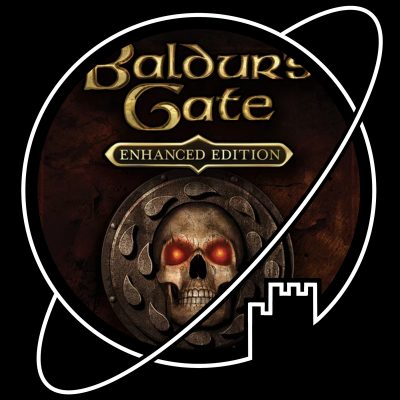- Video game developed by BioWare/Black Island/Overhaul Games
- Directed by James Ohlen/Trent Oster
- Published by Interplay Entertainment/Atari Inc.
- Published in 1998/2012
- Top-down role playing game, single player and online multiplayer
- Playing time: 40-100 hours
- Platforms: Microsoft Windows, MacOS, Linux, PlayStation 4, Android, iOS, Nintendo Switch, Xbox One
BioWare’s classic role-playing game Baldur’s Gate is the giant on the shoulders of which the modern action RPGs of the genre stand. Though the original dates to 1998, the 2012 remake makes the game accessible to modern players – and though the top-down isometric style may be out of vogue today and the combat system somewhat slow and complicated by modern standards, the story, style and progression hold up, especially for players familiar with Dungeons & Dragons or similar tabletop RPGs.


I have to admit something about Baldur’s Gate: the classic 1998 6-CD-ROMs-in-one-box version of the game was one of my very first ventures into the high fantasy genre. I distinctly remember sitting on my father’s lap (I was literally that young) building a character. I designed a dwarven fighter. I remember spawning outside Winthrop’s Inn, just with a quarterstaff, and walking around Candlekeep. I made my father read and translate all the flavour text, and I remember him trying to convince me to sell the Lynx Eye Gem Phlydia gave me after returning her book, but refusing, because the flavour text said dwarves liked gems (“but it said they like gold too!”). The game, its world, the possibilities, they completely blew me away – and I never even left Candlekeep. It took me a fair few years before I was old enough to actually play the game, but I think it would be fair to say that with the memories I have of this game, I cannot be entirely objective.
Baldur’s Gate is a top down roleplaying game, with relatively simple isometric graphics and limited voice acting, consisting of a great number of separate map areas (ranging from towns to dungeons to mountain fortresses and rocky coasts) that can each be explored with a party of the player character and up to five companions. Movement and combat appear to take place in real time, but (astonishingly) follow the turn-based rules of the tabletop RPG Dungeons & Dragons, down to weapon damage being indicated in dice (for example, 1D6+2, or 2D4, referencing 6- or 4-sided dice). Interactions with NPC take place through text menus with (often extensive) dialogue options. The setting is a relatively standard medieval high-fantasy setting, taken from the Forgotten Realms campaigns produced by Wizards of the Coast themselves.
Baldur’s Gate is a bizarre game. The D&D rules system, though allowing for a breadth of possibilities, is positively arcane for people not already familiar with it. The interface is manageable but far from streamlined. The graphics are simple. The combat can be tense but has you looking at a freaking scroll of text displaying dice rolls in the bottom of your screen more than at the actual characters fighting. Trying to describe it, it seems almost unimaginable that anyone would want to play it.
Yet, if you do know (some) D&D, and want a video game experience with a cool story, mysteries to unravel, in-depth character creation and progression, and a more laid-back style closer to a strategy game in controls, Baldur’s Gate is perfect for you. It is a way to scratch your D&D itch if your session’s been canceled. A way to get a taste of what D&D can be like if you’ve yet to find a group. A roleplaying game that does not rely on actions per minute or reflexes for your character to be a hero. A bath of nostalgia for some people.
I realise Baldur’s Gate might not be for everyone, and especially not for people used to more flashy, fast paced games that are the standard in the 2020s. But if you want a taste of what fantasy gaming was like in the last century, there is no better place to look than Baldur’s Gate.
The Enhanced Edition updates graphics, (mercifully) abolishes the need to switch CDs when entering every other map, and updates the rules system from the relic AD&D2E to the slightly simpler and more widely known D&D3.5E, and features a handful of quality of life improvements to the gameplay and the interface, but changes the game very little at its core – a new player seeking to take the plunge would do very well to buy the later edition.











